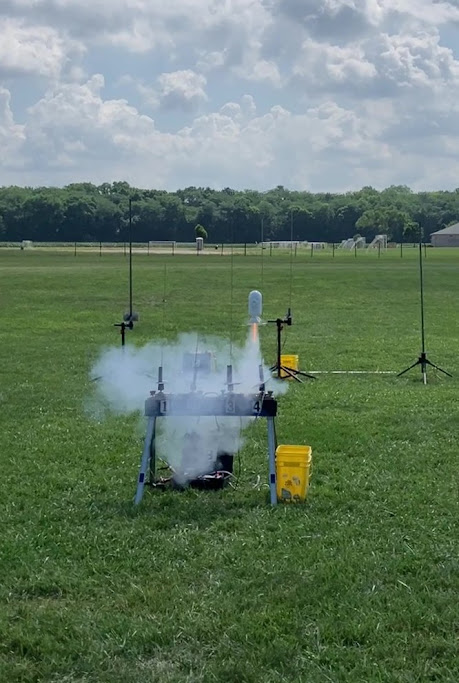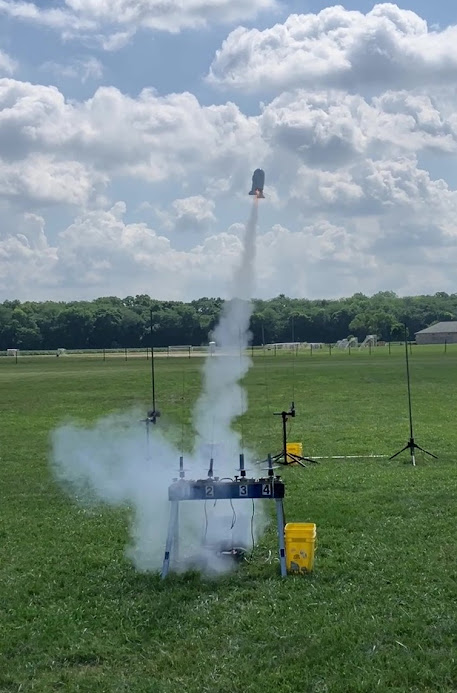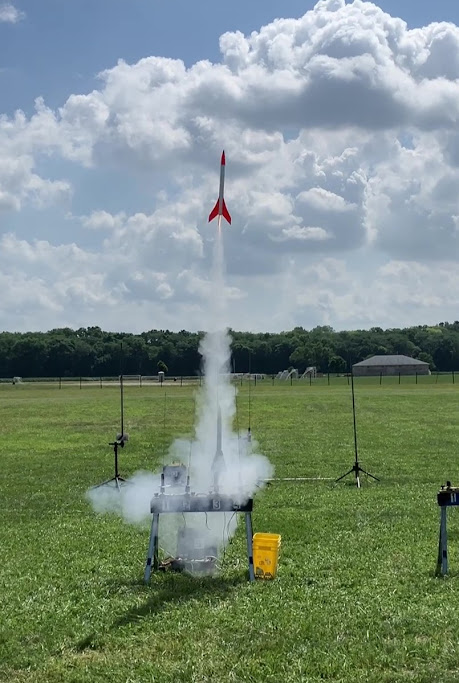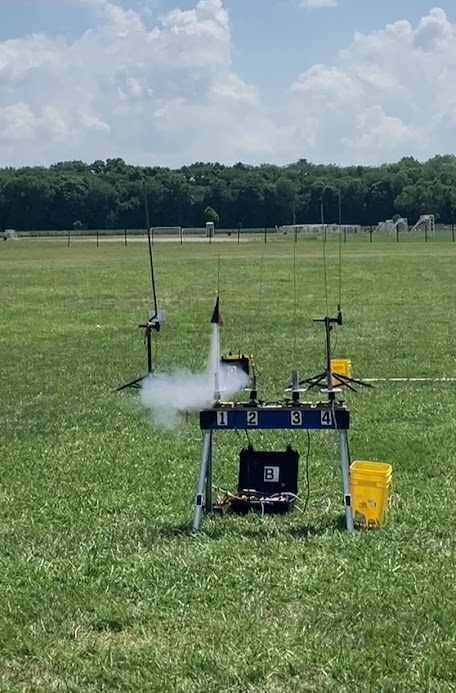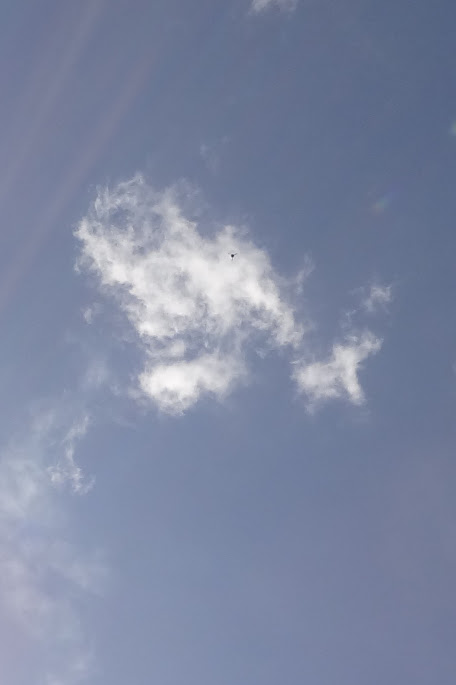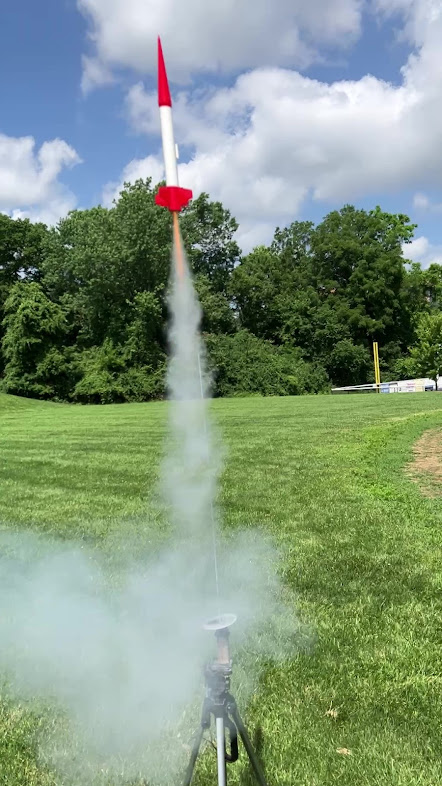Heat like this wasn't an issue when I roamed these streets as a kid growing up. Someone apparently felt like it was because they would only keep us in school for a half day the first few weeks of school because we didn't have air-conditioned classrooms. So, they'd turn us loose at noon so we could stay cool at home. Never happened. As soon as we finished lunch and changed clothes, we were outside in the heat, drinking hose water and going into the basement to lay on the concrete floor when the heat became too much for us. It rarely did. At night my brother and I contorted ourselves in our beds to try to feel the air from the fan that stood in the doorway of our room. Many a morning I'd wake up with my head hanging over the edge of the bed, then spend the rest of the day dealing with a stiff neck.
That said, B6-4 Field was a hellscape. I was surprised to find it empty, but no, I wasn't. When I stepped out of the car I could see the waves of heat coming off the asphalt of US 27. I could hear the screams and squeals of kids swimming at the YMCA and country club. They had the right idea. I set up dead center on the field, just behind second base. There was nothing resembling a breeze, so I figured I was safe. I'd spent most of the previous week finishing, painting and prepping a box of rockets for the WSR launch at eRockets field, only to have it cancelled by a pop-up air show. Undaunted, I switched gears and started prepping a box of small field birds. A couple I just switched from one tote to the other. This would come back to bite me.
First flight of the day was one that I recently rediscovered while doing my medium field prep work, the Estes Hex 3. I found it in a bag in an out of the way spot downstairs. I'd completely forgotten starting the project. Maria and I were on vacation after Tuesday, so while she followed her bliss out in the yard digging holes, I spent the day finishing the Hex 3. It would fly on a C6-0 because it's cardboard with a motor hook.
Color me impressed. The Hex 3 left the pad heading mostly straight with a slight tail back over my head, topping out at 158', quite a bit higher than expected. The Hex 3 would have been a great addition to my low & slow launches back during the pandemic.
Yeah, pretty sparse in the photo department. I tried going old school and using my Sony camera with the burst feature. It isn't quite as quick as it used to be. (A lot like me.) I switched back to the I phone immediately after checking out what I got of this flight.
At the 20% point, we had the MPC Nike Clipper, a wrecking ball that passed for RTF in the 1970's. This thing is beastly in many ways, but I'm in an MPC zone so I feel the need to give it a chance at flying.
I thought I had this loaded with a B6-4, but it was apparently a B4-4, which explains why the plug fit badly. It would have been nice if that occurred to me, but the sad fact is I only had the motors that were in the rockets I brought, so there would have been no chance at a change anyway. The B4-4 was up to the task, but just. The Clipper had a noticeable change in direction soon after clearing the rod, going from a straight flight to one heading out toward the trees in right field. It ejected well after it tipped over and made a quick run back to the field behind me at shortstop.
It seemed that it had been a while since I disrupted the photons, but in reality it had only been since 2023. I think it had been since 2020 that I probed said photons, so that might make the next round of B6-4 Field flights as they're always great small field birds on a B motor.
The Disruptor flight was much like the Nike Clipper was expected to be had it not had the mid-flight anomaly. As it was, the boost was largely straight, with altitude touching 266' before ejecting. The recovery sequence was quick and a touch exciting, crossing back over me through the sun and looking like it stood a good chance of a US 27 landing. In the end it fell quite a bit short of the road, settling off third base in foul territory at the base of the hill. It appears that I'm making panic a facet of every flight now as you can hear me saying "That's a goner," on most of the videos. It's why I stick to photos.






I stumbled onto the P.A.R.A. Bandersnatch while going through old club newsletters at NAR.org, not knowing that the same plan had been issued with another name. Either way, the rocket greatly resembles one of the rockets that graced the Estes Custom Parts Catalog back in the golden era. I built mine with the wingtip fins swept back instead of forward, but other than that I stuck with the plan. Decals were cobbled together from the scan of the Estes Skytracer.
This was a fairly surprising flight. It was on an A8-3 because of the comparatively small size of the Bandersnatch, but the performance didn't indicate an A motor. The Bandersnatch left the pad heading left and the flight topped out at 231'. Ejection occurred out over left center field and recovered in straightaway left. All in all, a pretty impressive B6-4 Field flight.





The Warlock was one of several homemade rockets I picked up as the only bidder on an eBay lot. Most of the rockets in the box were pretty standard, but all clearly self-designed. As each rocket came out of the box that day it got a name, and Warlock required no thought at all. The name shined through in big neon letters. It's ugly, definitely the ugliest in that eBay lot and possibly in my fleet. It's a BT-55 based bird, so I've recently been trying different nose cones and have settled on one of the Interceptor cones from the Sci-Fi assortment. Next I'll try different pod cones. Whatever the case, I'm still not satisfied with the look, but it's a pretty decent performer, especially on a B6-4 here at the namesake field.
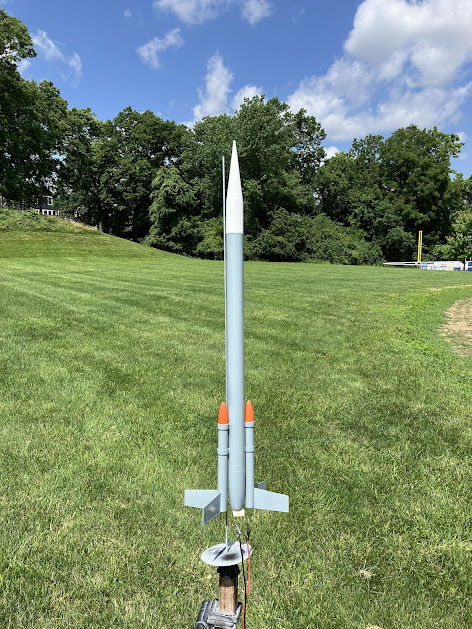
That said, on this day the Warlock left the pad looking strangely underpowered on the B6-4. With the rod angled slightly away from me toward the hill in center field, it clearly struggled after leaving the pad. The flight topped out at the 208' mark and ejection occurred long after it had tipped over, well under the 100' mark. Despite this, the chute filled immediately and the rocket only suffered a cracked fin fillet. Tougher than it looks.
I always liked the looks of the Estes Quasar, but to my knowledge never saw one on the pegs in my formative years. Prices had risen to the point that it made little sense to buy one when I got back into the hobby in 2001, but when I saw the Estes Metallizer on the shelves I decided "close enough". I switched out the foil body tube for one I could paint white, added a piece of foil tape and printed off a decal. Like I said, close enough.
The Quasar XL flight was what I expected the Warlock flight to be. It left the pad on the same flight path as the Warlock, but with noticeably more power. While the flight paths were the same, the Quasar never suffered a dip like the Warlock, powering on to a 247' apogee. It ejected just before it tipped over and the chute filled immediately, eventually landing 40' from the pad after a swinging recovery drift.
I've owned several Vector V kits over the years. My first was a homemade one that I built using scrap parts. It was one of the first rockets I brought to the field that stumped the band. They thought I dreamt it up. A few years later Carl released one and around the same time I found an opened Centuri kit on eBay complete except for decals. Both are flying at this time, but this one is the Semroc version.
This would be an A8-3 flight with a tiny Centuri chute on recovery. The V took off heading right off the pad and flew to 221'. Ejection occurred at apogee and the chute immediately showed little to no interest in anything recovery related. The rocket swapped the nose cone and tail section on the way down to the grass in short right field with me trying to employ body english to get the chute to fill. No such luck. The impact broke loose a fin, but it was an easy fix once I got home.
Heading back to B6-4s, the Centuri Stellar Hercules would be the next flight. This poor bird is on the third trip through the paint booth. I originally disliked the paint scheme I attempted, so I started over and disliked the orange that I chose for the project. For attempt #3 the Hercules spent a couple of years in all white before recently meeting the dreaded neon orange. I still need to paint a fin, but I'm kinda sick of the project and want it done and decaled, so this will be the final version.

I'm not sure if it was the hear or just me fat-fingering the iPhone controls, but something was decidedly off with the video for this flight. The flight itself was dead straight off the pad to 245' with ejection at apogee almost right over my head in short center field. Recovery drift took it back toward left field where things first looked slightly sketchy relative to US 27, but the drift eventually died out and it landed near the line in deep left field. Things got weird when I got home and downloaded the video. I'd set up near a crop of mushrooms, (lots of rain here recently,) and I was starting to think they were psychedelics. The video was 1 minute, 16 seconds long for a flight that took maybe 25 seconds. Long periods were spent focused on a cloud above the field, then I swung to the right and went sideways before heading back out toward left field and the eventual landing. Turns out I'd accidentally chosen Slo-Mo. I'd like to say that won't happen again, but two flights later it would rear its stoned head again.


It's rare that I drag out the Estes Converter, the last time being 2017. I believe this was purchased because I liked the idea of being able to choose the configuration of the rocket from flight to flight, and because it was on sale. While I can break the rocket down, I somehow managed to muck up the build so that it is only capable of flying in one configuration, the full stack. Maybe reading those instructions could have been a good idea. Wonder what happened to them.

The Converter was among the rockets in the tote I'd packed for eRockets Field, so instead of the B6-4 flight I was antici-pating, I got a C6-5. Actually, that's not a bad choice here. It's a fairly large, semi-RTF rocket and a cheap one at that. Pro tip: when you're used to flying A8s and the occasional B6 at a field this size, a C6 is a real attention getter. It left the pad leaning left toward the back corner of the field, deepest center where the terrace is. It appeared to be flirting with Woodfill Avenue when the ejection charge fired at the 284' mark. There are many hazards over that way, trees, the school, wires and the parking lot. The Converter looked to be about to experience an asphalt landing on Woodfill Avenue but instead kept carrying to the bushes at the base of the parking lot wall. This was literally the only safe area in the vicinity. The Converter is apparently a lucky bird.

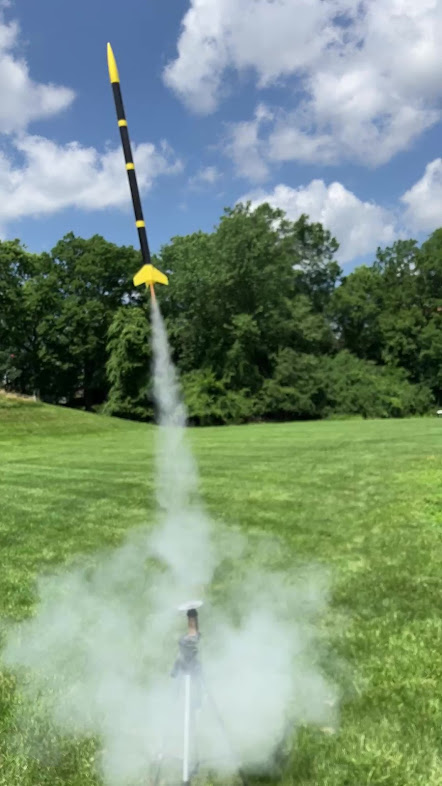




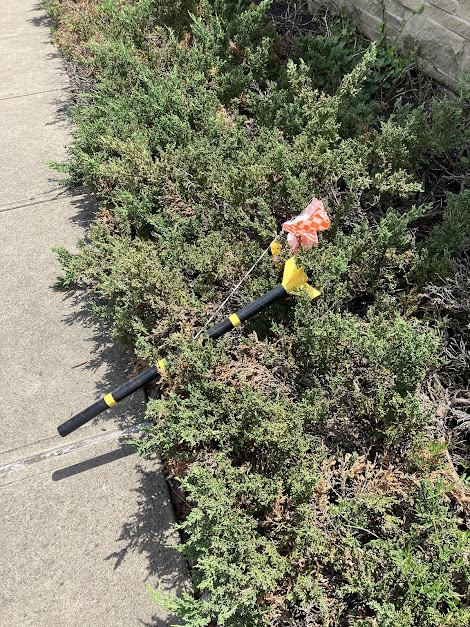
Earlier in the day I had decided to cut the flights off at 10 because of the heat, despite having more bullets in the bandolero. The rocket I chose for flight #10 was an old favorite, the Semroc Ruskie, one of Carl's Groonie kits that was based on the original concepts for the Estes Goonybirds. In my mind this was to be a B6-4 flight because I tried flying it here on an A8-3 once and was disappointed. I'd had a lot on my plate over the previous week, spending my vacation mornings finishing some of my long neglected projects and prepping for a Saturday launch that wouldn't happen because of a pop-up airshow. I may never know for sure, but I suspect that I prepped the Ruskie for an eRockets Field C6-5 flight.

As a death portrait, which this likely is, this serves pretty well. Especially since the phone was set up in slo-mo mode for the flight, making it essentially useless. There was trouble from the start of this flight. Unlike the Converter, which left the pad heading to the left, the Ruskie left heading right. Way right. Like Ted Nugent. It arced out over the Birdcage and popped the chute at 327', then began a lazy recovery drift toward US 27. There was minimal traffic at the moment, so an asphalt landing may have been survivable, but it cleared the road with plenty to spare. All I needed was for one more good gust to put it into the parking lot of the Apartment House of Horrors, but it never came. The Ruskie now resides at the top of the last tree before the parking lot.

Not really the note I wanted to day to end on, but that's what happens when you're not born with attention to detail, and Amazon is out. I left a lot on the table due to the heat, so I'm thinking I will be back to finish the rest of the tote sooner rather than later. I'm also hoping for a club launch that doesn't get cancelled, and to meet the Easter Bunny.

